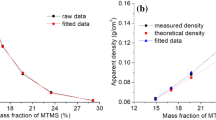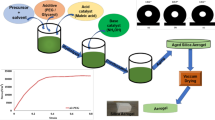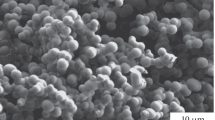Abstract
This work is a new approach to the study of the structural, mechanical and absorption properties of hybrid organic/inorganic silica-based aerogels. Diethoxydimethylsilane and tetraethoxysilane have been used as precursors. Changes in properties such as specific surface area, porous volume, pore radius, and surface texture and chemistry were researched as a function of the relative organic content. In addition, the absorption properties were tested for different organic liquids. The discrepancy in the absorption mechanisms and the kinetics of pure inorganic and hybrid samples were discussed. It was confirmed that swelling occurs in samples with high organic content, which, in turn, governs the absorption process. Finally, the mechanical behaviour was studied by uniaxial compression. A significant rise of the rupture strain up to 0.45 and a 10-fold decrease in the Young’s modulus to 7.8 MPa were measured in the dry samples by increasing the organic content. The mechanical response of the samples after saturation by the absorption of two reference oily liquids, namely, common motor oil and liquid polydimethylsiloxane, was also compared with the behaviour of dry samples. The presence of liquid within the sample reduced the value of the mechanical parameters in almost all cases. Moreover, the inclusion of organic chains also made the wet aerogels highly deformable. In summary, these first results suggest that tuning the organic ratio of the hybrid aerogels allows the control of not only the structural and mechanical properties but also the absorption properties.
Graphical abstract








Similar content being viewed by others
References
Alava M, Dubé M, Rost M (2004) Imbibition in disordered media. Adv Phys 53:83–175. doi:10.1080/00018730410001687363
Bear J (1988) Dynamics of fluids in porous media. Dover publications INC., New York
Adebajo M, Frost R, Kloprogge J, Carmody O, Kokot S (2003) Porous materials for oil spill cleanup: a review of synthesis and absorbing properties. J Porous Mater 10:159–170. doi:10.1023/a:1027484117065
Omidian H, Hashemi S, Sammes P, Meldrum I (1998) A model for the swelling of superabsorbent polymers. Polymer 39:6697–6704. doi:10.1016/s0032-3861(98)00095-0
Fratzl P, Barth F (2009) Biomaterial systems for mechanosensing and actuation. Nature 462:442–448. doi:10.1038/nature08603
Burgert I, Fratzl P (2009) Actuation systems in plants as prototypes for bioinspired devices. Philos Trans A Math Phys Eng Sci 367:1541–1557. doi:10.1098/rsta.2009.0003
Anderson AM, Carroll MK (2011) In: Aegerter MA, Leventis N, Koebel MM (eds), Aerogels handbook, advances in sol-gel derived materials and technologies, Springer-Verlag New York. doi:10.1007/978-1-4419-7589-8_4
Standeker S, Novak Z, Knez Ž (2007) Adsorption of toxic organic compounds from water with hydrophobic silica aerogels. J Colloid Interface Sci 310:362–368. doi:10.1016/j.jcis.2007.02.021
Anderson A, Carroll M, Green E, Melville J, Bono M (2010) Hydrophobic silica aerogels prepared via rapid supercritical extraction. J Sol-Gel Sci Technol 53:199–207. doi:10.1007/s10971-009-2078-z
Martín L, Ossó J, Ricart S, Roig A, García O, Sastre R (2008) Organo-modified silica aerogels and implications for material hydrophobicity and mechanical properties. J Mater Chem 18:207–213. doi:10.1039/b712553d
Mackenzie JD, Bescher E (1998) Structures, properties and potential applications of Ormosils. J Sol-gel Sci Technol 13:371–377
De la Rosa-Fox N, Morales-Flórez V, Toledo-Fernández JA, Piñero M, Mendoza-Serna R, Esquivias L (2007) Nanoindentation on hybrid organic-inorganic silica aerogels. J Eur Ceram Soc 11:3311–3316. doi:10.1016/.jeurceramsoc.2007.02.09
Randall J, Meador M, Jana S (2011) Tailoring mechanical properties of aerogels for aerospace applications. ACS Appl Mater Interfaces 3:613–626. doi:10.1021/am200007n
Morales-Flórez V, Rosa-Fox N, Piñero M, Esquivias L (2005) The cluster model: a simulation of the aerogel structure as a hierarchically-ordered arrangement of randomly packed spheres. J Sol-Gel Sci Technol 35:203–210. doi:10.1007/s10971-005-2363-4
Pierre A, Rigacci A (2011) In: Aegerter MA, Leventis N, Koebel MM (eds), Aerogels handbook, advances in sol-gel derived materials and technologies, Springer-Verlag New York. doi:10.1007/978-1-4419-7589-8_4
Choi S, Kwon T, Im H, Moon D, Baek D, Seol M, Duarte J, Choi Y (2011) A Polydimethylsiloxane (PDMS) sponge for the selective absorption of oil from water. ACS Appl Mater Interfaces 3:4552–4556. doi:10.1021/am201352w
Zhao X, Li L, Li B, Zhang J, Wang A (2014) Durable superhydrophobic/superoleophilic PDMS sponges and their applications in selective oil absorption and in plugging oil leakages. J Mater Chem A 2:18281–18287. doi:10.1039/c4ta04406a
Yoo S, Cohen C, Hui C (2006) Mechanical and swelling properties of PDMS interpenetrating polymer networks. Polymer 47:6226–6235. doi:10.1016/j.polymer.2006.06.035
Haraguchi K, Takehisha T (2002) Nanocomposite hydrogels; a unique organic-inorganic network structure with extraordinary mechanical, optical, and swelling/de-swelling properties. Adv Mater 14:1120–1124
Rosa-Fox N, Morales-Flórez V, Toledo-Fernández J, Piñero M, Esquivias L, Keiderling U (2008) SANS study of hybrid silica aerogels under “in situ” uniaxial compression. J Sol-Gel Sci Technol 45:245–250. doi:10.1007/s10971-008-1686-3
Babonneau F, Bois L, Maquet J, Livage J (1992) In: Vilminot S, Nass R, Schmidt H (eds), Eurogel’91 - progress in research and development of processes and products from sols and gels. Elsevier Science Publishers, Amsterdam.
Babonneau F (1994) Hybrid siloxane-oxide materials via sol-gel processing: Structural characterization. Polyhedron 13:1123–1130. doi:10.1016/s0277-5387(00)80249-1
Gedde U, Hellebuych A, Hedenqvist M (1996) Sorption of low molar mass silicones in silicone elastomers. Polym Eng Sci 36:2077–2082. doi:10.1002/pen.10603
Morales-Flórez V, Toledo-Fernandez JA, De la Rosa-Fox N, Piñero M, Esquivias L (2008) Percolation of the organic phase in hybrid organic–inorganic aerogels. J Sol-Gel Sci Technol 50:170–175. doi:10.1007/s10971-008-1874-1
Zhuravlev LT (2000) The surface chemistry of amorphous silica. Zhuravlev model. Colloids Surface A 173:1–38. doi:10.1016/S0927-7757(00)00556-2
Portaccio M, Della Ventura B, Mita D, Manolova N, Stoilova O, Rashkov I, Lepore M (2011) FT-IR microscopy characterization of sol–gel layers prior and after glucose oxidase immobilization for biosensing applications. J Sol-Gel Sci Technol 57:204–211. doi:10.1007/s10971-010-2343-1
Al-Oweini R, El-Rassy H (2009) Synthesis and characterization by FTIR spectroscopy of silica aerogels prepared using several Si(OR)4 and R′′Si(OR′)3 precursors. J Mol Struct 919:140–145. doi:10.1016/j.molstruc.2008.08.025
Wu W, Chuang C, Lin J (2000) Bonding geometry and reactivity of methoxy and ethoxy groups adsorbed on powdered TiO2. J Phys Chem B 104:8719–8724. doi:10.1021/jp0017184
Kruk M, Jaroniec M (2001) Gas adsorption characterization of ordered organic−inorganic nanocomposite materials. Chem Mater 13:3169–3183. doi:10.1021/cm0101069
Morales-Flórez V, Piñero M, de la Rosa-Fox N, Esquivias L, Anta J, Primera J (2008) The cluster model: A hierarchically-ordered assemblage of random-packing spheres for modelling microstructure of porous materials. J Non-Cryst Solids 354:193–198. doi:10.1016/j.jnoncrysol.2007.07.061
Morales-Flórez V, Rosa-Fox N, Piñero M, Esquivias L (2005) The cluster model: a simulation of the aerogel structure as a hierarchically-ordered arrangement of randomly packed spheres. J Sol-Gel Sci Technol 35:203–210. doi:10.1007/s10971-005-2363-4
Gruener S, Hermes H, Schillinger B, Egelhaaf S, Huber P (2015) Capillary rise dynamics of liquid hydrocarbons in mesoporous silica as explored by gravimetry, optical and neutron imaging: nano-rheology and determination of pore size distributions from the shape of imbibition fronts. Colloid Surface A. doi:10.1016/j.colsurfa.2015.09.055
Mosquera M, Rivas T, Prieto B, Silva B (2000) Capillary rise in granitic rocks: interpretation of kinetics on the basis of pore structure. J Colloid Interface Sci 222:41–45. doi:10.1006/jcis.1999.6612
Zhang Z, Gorman BP, Dong H, Orozco-Teran RA, Mueller DW, Reidy RF (2003) Investigation of polymerization and cyclization of dimethyldiethoxysilane by 29Si NMR and FTIR. J Sol-Gel Sci Technol 28:159–165. doi:10.1023/A:1026098729993
Leventis N, Lu H (2011) In: Aegerter MA, Leventis N, Koebel MM (eds), Aerogels handbook, advances in sol-gel derived materials and technologies, Springer-Verlag New York. doi: 10.1007/978-1-4419-7589-8_13
Piñero M, Morales-Florez V, De la Rosa-Fox N, Esquivias L (2005) Propiedades mecánicas de aerogeles híbridos de sílice. Bol Soc Esp Cerám V 44:291–203
De la Rosa-Fox N, Toledo-Fernández JA, Morales-Florez V, Piñero M, Esquivias L (2010) Creep and stress relaxation of hybrid organic-inorganic aerogels. Key Eng Mater 423:167–172. doi:10.4028/www.scientific.net/KEM.423.167
Kamitakahara M, Kawashita M, Miyata N, Kokubo T, Nakamura T (2001) Bioactivity and mechanical properties of polydimethylsiloxane (PDMS)-CaO-SiO2 hybrids with different PDMS contents. J Sol-Gel Sci Technol 21:75–81. doi:10.1023/a:1011261617377
Esquivias L, Morales-Flórez V, Piñero M, de la Rosa-Fox N (2005) Structure of bioactive mixed polymer/colloid aerogels. J Non-Cryst Solids 351:3347–3355. doi:10.1016/j.jnoncrysol.2005.08.007
Toledo-Fernández J, Mendoza-Serna R, Morales V, de la Rosa-Fox N, Piñero M, Santos A, Esquivias L (2007) Bioactivity of wollastonite/aerogels composites obtained from a TEOS–MTES matrix. J Mater Sci: Mater Med 19:2207–2213. doi:10.1007/s10856-007-3312-2
Toledo Fernández J, Mendoza-Serna R, Santos A, Piñero M, Rosa-Fox N, Esquivias L (2008) Improvement of the bioactivity of organic–inorganic hybrid aerogels/wollastonite composites with TiO2. J Sol-Gel Sci Technol 45:261–267. doi:10.1007/s10971-007-1674-z
Acknowledegments
V.M-F. thanks the post-doctoral grant from the “V Plan Propio de Investigación” from the University of Seville. In addition, contributions and help supplied by the ImageJ software package developers, from the National Institutes of Health of the US (http://imagej.nih.gov/ij), and from the webmasters and owners of www.citethisforme.com have also to be recognized. Technical staff of the CITIUS (Universidad de Sevilla) is also acknowledged for their help in the characterization of the samples and the funding from the “Proyecto de Excelencia, P09-TEP-5463” of the Consejería de Economía, Innovación, Ciencia y Empleo, Junta de Andalucía is acknowledged as well.
Author information
Authors and Affiliations
Corresponding author
Ethics declarations
Conflict of interest
The authors declare that they have no competing interests.
Electronic supplementary material
Rights and permissions
About this article
Cite this article
Morales-Florez, V., Piñero, M., Braza, V. et al. Absorption capacity, kinetics and mechanical behaviour in dry and wet states of hydrophobic DEDMS/TEOS-based silica aerogels. J Sol-Gel Sci Technol 81, 600–610 (2017). https://doi.org/10.1007/s10971-016-4203-0
Received:
Accepted:
Published:
Issue Date:
DOI: https://doi.org/10.1007/s10971-016-4203-0




